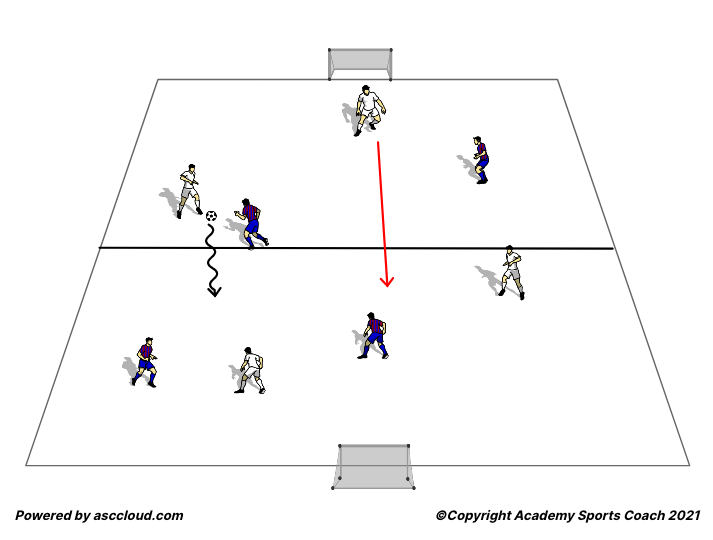The dimensions of the activity space – length, width, and shape – are perhaps the most critical factors in successful outcomes. The coach must have a clear idea of objectives when determining dimensions. The coach must also be willing to alter the sizes if, in observation, the activity is not meeting its objectives.
The layout of the field may include specific zones – for example, outside channels, the division of the area into halves, thirds, or fourths, or central grids. The activity may specify certain restrictions associated with zones such as limited numbers of players, their roles, limits on actions such as touch count, criteria for entry, and so on.
As an initial consideration, we should look at the ratio of the activity space area versus the number of active players. For example, if we have a grid 30 meters long by 20 meters wide, the area is 600 square meters (m2). If we choose to use this space for a 3v3 small-sided game (SSG), the per-player space is 100 m2. A common area for a 1v1 SSG is 80 m2, or about 40 m2/player. A typical adult full-size pitch is approximately 105x68m or 7140 m2. Divided by 22 (the number of players), this results in about 325 m2/player. The differences in per-player spaces influences the varied demands of the 1v1 SSG, 3v3 SSG, and 11v11 game.
The activity space impacts each of the dimensions of player development. For example:
| Technical | Smaller spaces per player will require different types of technical abilities versus larger spaces per player |
| Tactical | The use of zones and restrictions in conjunction with the rules of the activity will require players to analyze and make choices based on the non-negotiables and principles of play |
| Physical | Larger spaces per player will impose different physical demands (e.g., sprints) versus smaller spaces (e.g., agility, fine motor skills) - in conjunction with space, the coach can utilize durations to create specific physical (metabolic) outcomes. |
| Psychosocial | Smaller spaces per player can increase cognitive load due to an increased rate of stimuli and more time-sensitive decision-making requirements |




Although the per-player area is identical, the technical and tactical demands can be significantly different. We have used SSGs as an example, other types of activities – rondos, positional play, patterns of play, isolated skills development – also have a relationship between demands (technical, tactical, physical, psychosocial) and the layout of the space.
As noted above, the coach must clearly understand objectives and be observant of how the players’ use of space influences outcomes. A typical example is a rondo, as shown below:

If the space is too large, the outside players will simply knock the ball around, forcing the inside defender to chase. If the area is too small, the inside player will have little difficulty winning the ball on any pass. The goal would be to have a space sized to present challenges to both outside and inside players within their technical and tactical abilities. If the initial space layout is not working, it’s the responsibility of the coach to step in and make an adjustment.
The activity space may also include zones that – in conjunction with rules – either create a tactical problem or encourage patterns of play desired by the coach. Here are some examples of space layouts:




While cones may be used to separate zones or channels, flat markers often provide a better solution due to their low profile and less likelihood of disturbing play.
In summary, the dimensions and layout of the activity space form an essential element in the success of an activity. Coaches should carefully consider the use of space and be prepared to make adjustments based on the players’ responses.